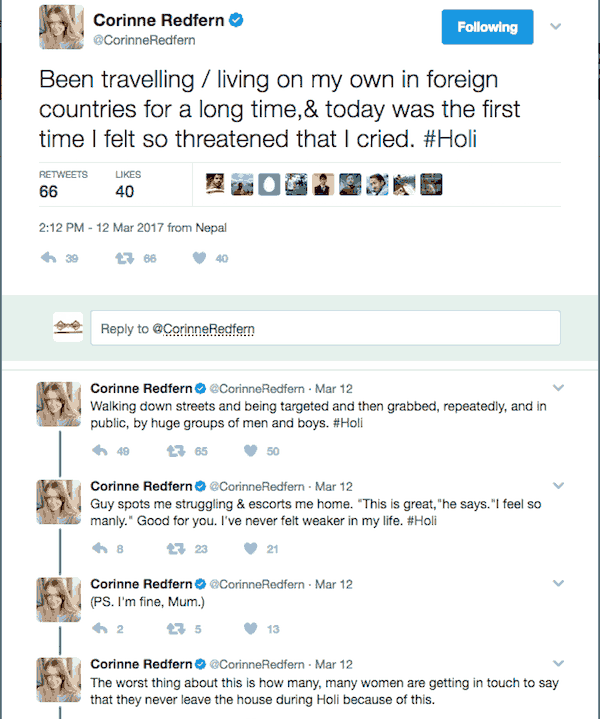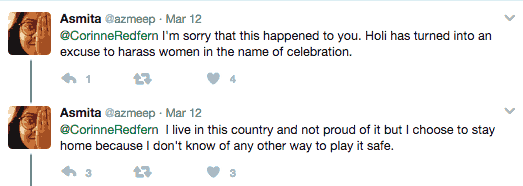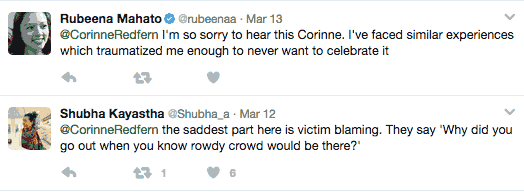Holi is the Hindu festival of color and, as such, it’s supposed to be a day of “celebrations” (see reference below for a short, interesting history). It’s celebrated both in Nepal and India.
We in Nepal celebrated ours last Sunday, March 12.
But for many girls and women in the Indian Subcontinent — whether local or foreign — a celebration Holi is not!
I discovered and learned that, recently, via a foreign journalist’s tweet thread describing her ordeal that day.
Thread about deplorable/horrible behavior by some boys & men yesterday on d streets of KTM under d guise of “celebrating” #Holi. #Nepal https://t.co/5PPZpBYFVo
— Dorje Gurung (@Dorje_sDooing) March 13, 2017
Here’s the thread.

And here, also from the thread, is a tweet by a Nepalese woman saying why, for that reason, she stays home during Holi.
Another example of a Nepalese woman who chooses to stay home, followed by another one who describes the general victim-blaming attitude of Nepalese, especially when the victim is a girl or woman.
@CorinneRedfern Your experience makes my blood boil (& I am sure as it does those of many girls & women of this beautiful country +
— Dorje Gurung (@Dorje_sDooing) March 14, 2017
@CorinneRedfern + & otherwise beautiful ppl.) Victim blaming girls & women 4 their suffering is the norm, more so than in many countries +
— Dorje Gurung (@Dorje_sDooing) March 14, 2017
@CorinneRedfern + I have lived in. It’s ingrained in our culture & mentality, forcing girls & women 2 make choices (staying home during +
— Dorje Gurung (@Dorje_sDooing) March 14, 2017
@CorinneRedfern + #Holi 4 eg.) which they shud NOT have to.
A recent informal online poll discovered 98% of female respondent reported +
— Dorje Gurung (@Dorje_sDooing) March 14, 2017
@CorinneRedfern + being harassed in public vehicles. Read abt it here: https://t.co/HKNakhYoSR +
— Dorje Gurung (@Dorje_sDooing) March 14, 2017
@CorinneRedfern + It’s partly d victim blaming culture that females don’t feel safe even to speak up, which I’m sure is partly to blame +
— Dorje Gurung (@Dorje_sDooing) March 14, 2017
@CorinneRedfern + 4 d appalling fact that SUICIDE is the biggest killer of our females. Read abt it here: https://t.co/vvqB8aPsuB +
— Dorje Gurung (@Dorje_sDooing) March 14, 2017
@CorinneRedfern + Yes, girls & women in Nepal opt out of NOT only #Holi, b/c of our culture & mentality, they even opt out of life! 🙁 🙁
— Dorje Gurung (@Dorje_sDooing) March 14, 2017
On that same day, I discovered a survey which I also tweeted.
Were u harassed yesterday? If so take this survey!
Harassers count on ur silence 2 continue 2 b who they r & 2 continue 2 do what they do. https://t.co/wykpDagLDW
— Dorje Gurung (@Dorje_sDooing) March 14, 2017
(Click here to go to the survey directly if interested in taking it. There is still time, the deadline is March 18.)
I followed that thread up with the following tweet that evening.
Many girls & women stayed home yesterday, on #Holi, for fear of being sexually harassed.
How many boys & men went out TO harass? #Nepal
— Dorje Gurung (@Dorje_sDooing) March 14, 2017
To expand on the tweet…
What percentage of our girls & women stay home during Holi because of fear of sexual harassment?
How many girls and women last Sunday had the kind of emotionally, mentally, and psychologically scaring and deeply troubling experience that Corrinne Redfern had? How many?
How many have had that experience to date? How many?
How many of them have been blamed for the experience? How many?
And to put the spotlight on the boys and men.
How many boys and men go out during Holi because of the potential for cheap thrills, groping and sexually harassing girls and women? (For most, they can’t be more than just cheap thrills, though, I’m sure, for some there is also the element of power play — Nepal, after all, is a highly patriarchal society.)
How many go out with the express intention of sexually harassing girls and women?
What’s more, the problem is probably NOT limited only to Holi.
We have other festivals, such as Indra Jatra, pulling of the Machindranath chariot, Krishna Jayanti, Bhoto Jatra, to name just a few, and public events, open air concerts and parties, where huge crowds gather. Large crowds provide both really close physical proximity, therefore the opportunity, and the necessary anonymity and shield, predators with a proclivity for such anti-social behaviors are looking for.
The consequences for girls and women, in most cases, is devastating! But most in this highly patriarchal society will blame the victim…for her poor judgement.
The reality, however, is that we are failing to create an environment, a society, a culture where girls and women also feel as safe as boys and men!
What do you think?
* * * * * * * *
May 11 Update
In the original post, I had made the following statement: Only recently, suicide claimed a young girl at our organization COMMITTED‘s project site in Sindhupalchok. Turns out, I had read the information wrong and so the statement has been completely removed.
The results of the informal and unscientific online poll about harassment during Holi conducted by friends of mine were published in The Kathmandu Post on April 15. I would recommend a read of the article as it’s quite informative, in spite of its limitations.
References:
Not referenced in the post but relevant….
Feminism in India (no date). Reading Caste In Holi: The Burning Of Holika, A Bahujan Woman. A short history of Holi, about which, I must admit, I didn’t know anything!
BuzzFeed (Jan. 2017). Indian Parents Aren’t Raising Their Sons Right, And It’s Endangering India’s Women. Beautifully written piece published in the wake of the mass molestations in Bangalore on New Year’s Eve. To make it applicable to Nepal, all you have to basically do is replace Indian with Nepalese. In other words, her descriptions of her (Indian) society and of their attitude towards and treatment of females is pretty much a description of Nepal. What she recommends in order for her society to make social progress, therefore, is also relevant — and applicable — to Nepalese society.


